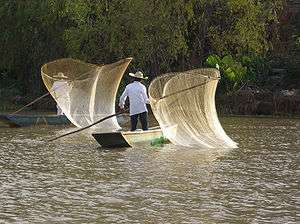Purépecha
|
Purépecha children at the 2015 Muestra de Indumentaria Tradicional de Ceremonias y Danzas de Michoacán | |
| Total population | |
|---|---|
| (127,318[1] (2010 census)) | |
| Regions with significant populations | |
| Michoacán | |
| Languages | |
| Purépecha, Mexican Spanish | |
| Religion | |
| Purépecha religion |
The Purépecha or Tarascans (endonym P'urhépecha [pʰuˈɽepet͡ʃa]) are a group of indigenous people centered in the northwestern region of the Mexican state of Michoacán, principally in the area of the cities of Cherán and Pátzcuaro.
They are also known by the exonym Tarascan.
Territory
The Purépechas occupied most of Michoacán's territory, but they also occupied some of the lower valleys of both Guanajuato and Jalisco. Celaya, Acámbaro, and Yurirapúndaro were all in Tarascan territory. Today Purépecha people live mostly in the highlands of central Michoacan around lakes Pátzcuaro and Cuitzeo.
History
The Purépechas established the Tarascan state in the 14th century, which was one of the major pre-Columbian civilizations of Mesoamerica. Their capital city was Tzintzuntzan. Purépecha architecture is noted for step pyramids in the shape of the letter "T". Pre-Columbian Purépecha artisans made feather mosaics making extensive use of hummingbird feathers which were a highly regarded as luxury good throughout the region.
The Purépecha were never conquered by the Aztec Empire, despite several attempts by the Aztecs to do so, including a fierce war in 1479. This was probably due to the presence of metal ores in Purépecha lands and their knowledge in metalsmithing, which was far superior to that of the Aztecs; these skills have persisted in their descendants and are still widely regarded today, in particular their coppersmithing. Even though they were enemies with the Aztecs, the Aztecs still traded with them, mainly for metal tools and weapons.

After hearing of the Spanish conquest of the Aztec Empire and having the native population much diminished by an epidemic of smallpox, the cazonci Tangaxuan II pledged his allegiance as a vassal of the King of Spain without a fight in 1525. It is believed that the Spanish conquistador Cristóbal de Olid, upon arriving in the Tarascan State in present-day Michoacán, probably explored some parts of Guanajuato in the early 1520s. A legend relates of a 16- to 17-year-old Purépecha Princess Erendira, who led her people into a fierce war against the Spanish. Using stolen Spanish horses, her people learned to ride into battle. In 1529–1530, the Spanish forces entered Michoacán and some parts of Guanajuato with an army of 500 Spanish soldiers and more than 10,000 Indian warriors.

Then in 1530, the sadistic President of the Real Audiencia Nuño de Guzmán, a conquistador notorious for his ruthlessness and brutality towards Native Indians, plundered the region and gruesomely executed Tangaxuan II, destroying the Purépecha State and provoked a chaotic situation and widespread violence. In 1533 the Crown sent to Michoacan an experienced Oidor (Judge of the Audiencia) and later bishop, Don Vasco de Quiroga, who managed to establish a lasting colonial rule. The Spanish took it as their name, for reasons that have been attributed to different, mostly legendary, stories. The lands of the Purépecha was subjected to serious deforestation during the Spanish colonial period. [2]
Religion
Many traditions live on, including the "Jimbani Uexurhina" or new year that is celebrated on February 1. The celebration has traditional indigenous and Catholic elements. The community lights a fire called the chijpiri jimbani or "new fire" as part of a ceremony that honors the four elements. Mass is also celebrated in the P'urhépecha language.
Language

The Purépecha language is spoken by nearly 200,000 people in Mexican state of Michoacán. Following Mexico's 2000 indigenous language law, indigenous languages including Purépecha were granted official status equal with Spanish in the areas where they are spoken. Recently, educational instruction in the language has been introduced in the local school systems. Additionally, many Purépecha communities offer classes and lessons in the language.
See also
References
- ↑ "Purépecha". Secretaría de Educación Pública. Retrieved 21 September 2015.
- ↑ http://www.unesco.org.uy/ci/fileadmin/phi/aguaycultura/Mexico/14_Purepechas.pdf
External links
- P'urhépecha WEB Page and Community
- P'urhépecha Literature
- Beautiful P'urhépecha women
- P'urhépecha mother with her son
- Learn about archaeological research with a P'urhépecha Community
- Chap. 9: The Twilight of the Gods: The Arrival of the Purépecha (Cycles of the Sun, Mysteries of the Moon; includes area map)
